Podcast: Play in new window | Download
Subscribe: Apple Podcasts | RSS
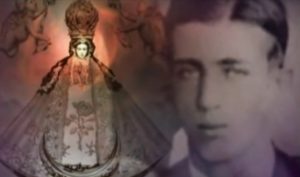 Outside the town of Cotija de la Paz in the Mexican state of Michoacán, a teenage boy was wandering about his family’s landholdings which numbered into the thousands of acres. The boy’s name was Rafael Guízar y Valencia, one of the eleven children of Prudenzio Guízar and Natividad Valencia. It was a summer day in the year 1894 and as was typical of that time of year, a sudden thunderstorm started to pour down rain and fill the sky with lightening. The storm was particularly ferocious, but the young Rafael was intrigued by nature’s violent display and sat on a hill watching the storm. Amid the dark swirling clouds and lightning bolts, the teenage boy claimed to see an image of Jesus. The sighting so alarmed him that he ran to seek refuge from the storm and entered a chapel dedicated to the Virgin of San Juan de los Lagos on his parent’s property. He prayed to the statue of the Virgin and according to what Rafael would tell his parents later, the statue appeared to emit its own bright luminescence. It was at that moment in the chapel that the young blue-eyed Rafael decided to become a priest and devote his life to God. Rafael’s story is very closely intertwined with the history of Mexico, and despite the many challenges of the times Rafael Guízar never gave up his spiritual and pastoral devotions.
Outside the town of Cotija de la Paz in the Mexican state of Michoacán, a teenage boy was wandering about his family’s landholdings which numbered into the thousands of acres. The boy’s name was Rafael Guízar y Valencia, one of the eleven children of Prudenzio Guízar and Natividad Valencia. It was a summer day in the year 1894 and as was typical of that time of year, a sudden thunderstorm started to pour down rain and fill the sky with lightening. The storm was particularly ferocious, but the young Rafael was intrigued by nature’s violent display and sat on a hill watching the storm. Amid the dark swirling clouds and lightning bolts, the teenage boy claimed to see an image of Jesus. The sighting so alarmed him that he ran to seek refuge from the storm and entered a chapel dedicated to the Virgin of San Juan de los Lagos on his parent’s property. He prayed to the statue of the Virgin and according to what Rafael would tell his parents later, the statue appeared to emit its own bright luminescence. It was at that moment in the chapel that the young blue-eyed Rafael decided to become a priest and devote his life to God. Rafael’s story is very closely intertwined with the history of Mexico, and despite the many challenges of the times Rafael Guízar never gave up his spiritual and pastoral devotions.
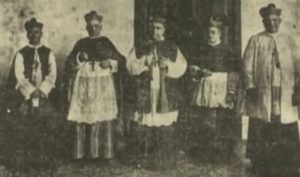 Rafael’s parents supported his decision and soon the boy entered the seminary at Zamora, Michoacán. Rafael became a priest on June 6, 1901 at the age of 23, and soon embarked on one of his countless “apostolic missions,” to serve many who lived the rural communities and across the countryside in central Mexico. Because he was from a family of means, Rafael used his own money to establish a school for poor girls and two colleges for boys, in addition to setting up the Congregation of Missionaries of Our Lady of Hope, a religious community, in 1903. The year 1910 saw the beginnings of the Mexican Revolution and the first of two major persecutions of the Catholic Church in early 20th Century Mexico. Guízar saw the need to minister to soldiers on both sides, especially on the battlefield to administer the Catholic sacraments such as confession and last rites. He was on the revolutionary government’s black list, however, and had a bounty on his head. With his congregation wiped out and his public career gone, Father Rafael Guízar went underground, so to speak, and fled to the safety of Mexico City where he set up a printing press and began to publish evangelical materials. The government shut him down and he fled the city, accompanying factions of the revolutionary army in disguise – sometimes as a junk dealer, a doctor or a musician – but always ministering to the soldiers in secret and fulfilling his duties as a priest. With a price still on his head, he was captured in 1915 and sent to jail to await a firing squad. Guízar protested and claimed that they arrested the wrong man and that he really wasn’t Father Rafael Guízar or a Catholic priest at all, but a poor traveling musician. One of the jailers gave him an accordion and told him to play. Father Rafael did just that and filled the jail with marvelous renditions of popular Mexican folk songs. Everyone was entertained and he soon had them convinced that they had arrested the wrong man. One of his captors was noted as saying, “Here’s 25 pesos. Take the accordion and go.” Little did they know that as a priest-in-training, the future saint was the head of a musical group he founded at the seminary called “Los Gallos Misticos,” or in English, “The Mystical Roosters.”
Rafael’s parents supported his decision and soon the boy entered the seminary at Zamora, Michoacán. Rafael became a priest on June 6, 1901 at the age of 23, and soon embarked on one of his countless “apostolic missions,” to serve many who lived the rural communities and across the countryside in central Mexico. Because he was from a family of means, Rafael used his own money to establish a school for poor girls and two colleges for boys, in addition to setting up the Congregation of Missionaries of Our Lady of Hope, a religious community, in 1903. The year 1910 saw the beginnings of the Mexican Revolution and the first of two major persecutions of the Catholic Church in early 20th Century Mexico. Guízar saw the need to minister to soldiers on both sides, especially on the battlefield to administer the Catholic sacraments such as confession and last rites. He was on the revolutionary government’s black list, however, and had a bounty on his head. With his congregation wiped out and his public career gone, Father Rafael Guízar went underground, so to speak, and fled to the safety of Mexico City where he set up a printing press and began to publish evangelical materials. The government shut him down and he fled the city, accompanying factions of the revolutionary army in disguise – sometimes as a junk dealer, a doctor or a musician – but always ministering to the soldiers in secret and fulfilling his duties as a priest. With a price still on his head, he was captured in 1915 and sent to jail to await a firing squad. Guízar protested and claimed that they arrested the wrong man and that he really wasn’t Father Rafael Guízar or a Catholic priest at all, but a poor traveling musician. One of the jailers gave him an accordion and told him to play. Father Rafael did just that and filled the jail with marvelous renditions of popular Mexican folk songs. Everyone was entertained and he soon had them convinced that they had arrested the wrong man. One of his captors was noted as saying, “Here’s 25 pesos. Take the accordion and go.” Little did they know that as a priest-in-training, the future saint was the head of a musical group he founded at the seminary called “Los Gallos Misticos,” or in English, “The Mystical Roosters.”
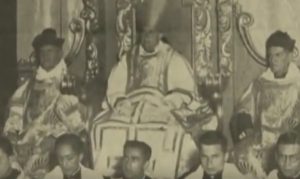 As soon as he left the hands of the revolutionaries Guízar escaped to Texas and by 1916 he found his way to Guatemala where he stayed for 8 months. After Guatemala it was on to Cuba; he had a sister who had married well and was living a good life in Havana. Besides a brief stint in Colombia, he lived in Havana for 3 years. Everywhere he went, even if it was for a brief time, Guízar set up missions to help the poor and underserved. He was relentless in this regard and worked tirelessly to assist those in need. By late 1919 Guízar was named Bishop of Veracruz and was sent back to Mexico. By the time of his arrival on January 4, 1920, the state of Veracruz had suffered a terrible earthquake in which thousands of people were killed, especially in the interior of the state. Guízar forewent the pomp and circumstance of an official investiture and hit the ground running when he arrived at his new post. He immediately took a train to the interior, the areas most affected by the quake, to give assistance and solace to those in the direst need. The first years of his term as bishop were marked by his intense approach to evangelization and helping the rural areas of his jurisdiction. Guízar was often seen traveling by burro or on foot to get to the communities that needed him the most. His pastoral outreach was once again thwarted by the changing political situation in Mexico by 1926 with the outset of the Cristero Rebellion.
As soon as he left the hands of the revolutionaries Guízar escaped to Texas and by 1916 he found his way to Guatemala where he stayed for 8 months. After Guatemala it was on to Cuba; he had a sister who had married well and was living a good life in Havana. Besides a brief stint in Colombia, he lived in Havana for 3 years. Everywhere he went, even if it was for a brief time, Guízar set up missions to help the poor and underserved. He was relentless in this regard and worked tirelessly to assist those in need. By late 1919 Guízar was named Bishop of Veracruz and was sent back to Mexico. By the time of his arrival on January 4, 1920, the state of Veracruz had suffered a terrible earthquake in which thousands of people were killed, especially in the interior of the state. Guízar forewent the pomp and circumstance of an official investiture and hit the ground running when he arrived at his new post. He immediately took a train to the interior, the areas most affected by the quake, to give assistance and solace to those in the direst need. The first years of his term as bishop were marked by his intense approach to evangelization and helping the rural areas of his jurisdiction. Guízar was often seen traveling by burro or on foot to get to the communities that needed him the most. His pastoral outreach was once again thwarted by the changing political situation in Mexico by 1926 with the outset of the Cristero Rebellion.
The Cristero War, also known as the Cristero Rebellion or La Cristiada, was a brutal internal conflict that lasted between 1926 and 1929 and pitted rural Catholic lay people and clergymen against the forces of the anti-Catholic, anti-clerical central government in Mexico City headed by President Plutarco Calles. Calles sought to enforce the anti-clerical articles of the new Constitution of 1917 produced by the Mexican Revolution and enacted legislation to reduce the power of the Church. This so-called Calles Law was seen as a continuation of the long struggle of Church versus State that dated back to La Reforma of the mid-19th Century. Under this law restrictions were placed on the Catholic clergy and the power of the Church was further limited. Popular religious celebrations were suppressed in local communities along with the number of priests allowed to serve in Mexico as a whole. A few uprisings happened in 1926 and full-scale violence ensued by 1927, most notably in the countryside of the states of Zacatecas, Jalisco and Michoacán. By 1927 all priests were prohibited from celebrating the mass and ordered confined to their residences or to relocate to urban areas. Most clergy did not take part in violence, although many, like Bishop Guízar, defied the authorities and continued performing Catholic rites. Guízar’s seminary was the only functioning training center for Catholic priests during the entire conflict and had over 300 young men enrolled. The Church hierarchy in Mexico tacitly supported the grassroots rebellion and the authorities in Rome condemned the Mexican government. By 1928, Dwight Whitney Morrow, the US Ambassador to Mexico at the time became involved and eventually helped broker a truce between government forces and the Cristeros. In the end, approximately a quarter million people died in the fighting. Because he was a controversial figure and once again wanted for his subversive activities, Bishop Guízar spent a little less than two years abroad for a second time, going back to Texas, Cuba, Colombia and Guatemala to check on the progress of the missions he had founded in those areas less than 10 years before. In 1929 he found himself back in Mexico and assumed his pre-Cristero activities
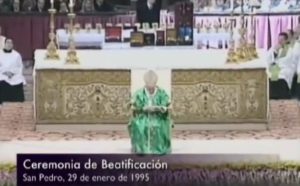 The end of the Cristero Rebellion did not end the hard times for the Catholic Church in Mexico, nor did it make life easier for Bishop Guízar. To limit the power of the Church, Adalberto Tejada Olivares, governor of the State of Veracruz declared in 1931 that there would only be one priest for 100,000 citizens. Once again, things were tense between government and religious authorities, and July 25, 1931 saw another tipping point, the murder of a 23-year-old priest, Angel Dario Acosta. On that July evening, government militiamen entered the Assumption Cathedral in the city of Veracruz and opened fire, killing Angel Acosta who had just baptized an infant. The incident so outraged Bishop Guízar that he ordered all churches throughout the state to be closed in protest. Feeling the political pressure of this move, Governor Tejada ordered Guízar to be shot on sight and offered a bounty on his head. The bishop’s reaction was not to flee the country but to head directly to the governor’s office and confront Tejada face-to-face. The bishop told the governor that he respected authority but wished that the governor would shoot him himself instead of having a poor parishioner kill him to collect the few pesos bounty. Impressed by Guízar’s bravery and honor, Tejada rescinded the order and told the bishop he was free to go about his business. The governor also lifted all the restrictions he had placed on the church in Veracruz. After this, Bishop Guízar continued his missionary work and ministered to tens of thousands of people in need. The future saint had suffered for many years from a variety of health conditions, from tuberculosis to diabetes to circulation problems. His very busy schedule and his tireless dedication to his causes exacerbated his health issues. Knowing that his end was near and not wanting any trouble taken for elaborate funeral services, in his final days Guízar was quoted as saying, “I want to die like the poorest of the poor.” He had a heart attack and passed away on June 6, 1938 at the age of 60.
The end of the Cristero Rebellion did not end the hard times for the Catholic Church in Mexico, nor did it make life easier for Bishop Guízar. To limit the power of the Church, Adalberto Tejada Olivares, governor of the State of Veracruz declared in 1931 that there would only be one priest for 100,000 citizens. Once again, things were tense between government and religious authorities, and July 25, 1931 saw another tipping point, the murder of a 23-year-old priest, Angel Dario Acosta. On that July evening, government militiamen entered the Assumption Cathedral in the city of Veracruz and opened fire, killing Angel Acosta who had just baptized an infant. The incident so outraged Bishop Guízar that he ordered all churches throughout the state to be closed in protest. Feeling the political pressure of this move, Governor Tejada ordered Guízar to be shot on sight and offered a bounty on his head. The bishop’s reaction was not to flee the country but to head directly to the governor’s office and confront Tejada face-to-face. The bishop told the governor that he respected authority but wished that the governor would shoot him himself instead of having a poor parishioner kill him to collect the few pesos bounty. Impressed by Guízar’s bravery and honor, Tejada rescinded the order and told the bishop he was free to go about his business. The governor also lifted all the restrictions he had placed on the church in Veracruz. After this, Bishop Guízar continued his missionary work and ministered to tens of thousands of people in need. The future saint had suffered for many years from a variety of health conditions, from tuberculosis to diabetes to circulation problems. His very busy schedule and his tireless dedication to his causes exacerbated his health issues. Knowing that his end was near and not wanting any trouble taken for elaborate funeral services, in his final days Guízar was quoted as saying, “I want to die like the poorest of the poor.” He had a heart attack and passed away on June 6, 1938 at the age of 60.
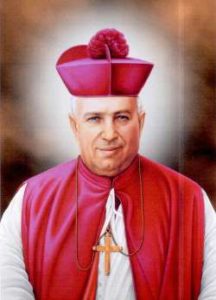 Twelve years after his death, the Archdioces of Veracruz decided to exhume the body of Rafael Guízar y Valencia and inter him inside the Xalapa Cathedral. When they opened the coffin, they saw that his body was still intact and incorrupt, even down to his bight blue eyes. While this is not a prerequisite for sainthood, it is considered by the Catholic Church to be a good sign, and Bishop Guízar was put on the track to sainthood, first declared a “servant of god,” then “venerable.” Pope John Paul the Second beatified him on January 29, 1995. After the beatifcation, church officials investigated two medical miracles attributed to Guízar’s intercession. In one instance a woman named Cirana Rivera who was infertile due to a hereditary medical condition gave birth to a healthy boy after praying to the bishop. The other medical miracle also involved the birth of a baby. Valentina Santiago was told by her doctor that her baby would be born with severe birth defects as evidenced by various ultrasound images. During her pregnancy Valentina went to the Xalapa cathedral daily and prayed to Rafael Guízar, and the baby was born without the defects as seen in the many ultrasounds. The humble bishop was canonized by Pope Benedict XVI on October 15, 2006 and now takes his rightful seat among Mexico’s pantheon of saints.
Twelve years after his death, the Archdioces of Veracruz decided to exhume the body of Rafael Guízar y Valencia and inter him inside the Xalapa Cathedral. When they opened the coffin, they saw that his body was still intact and incorrupt, even down to his bight blue eyes. While this is not a prerequisite for sainthood, it is considered by the Catholic Church to be a good sign, and Bishop Guízar was put on the track to sainthood, first declared a “servant of god,” then “venerable.” Pope John Paul the Second beatified him on January 29, 1995. After the beatifcation, church officials investigated two medical miracles attributed to Guízar’s intercession. In one instance a woman named Cirana Rivera who was infertile due to a hereditary medical condition gave birth to a healthy boy after praying to the bishop. The other medical miracle also involved the birth of a baby. Valentina Santiago was told by her doctor that her baby would be born with severe birth defects as evidenced by various ultrasound images. During her pregnancy Valentina went to the Xalapa cathedral daily and prayed to Rafael Guízar, and the baby was born without the defects as seen in the many ultrasounds. The humble bishop was canonized by Pope Benedict XVI on October 15, 2006 and now takes his rightful seat among Mexico’s pantheon of saints.
REFERENCES
The official Saint Rafael Guízr y Valencia web site, rafaelguizar.org (in Spanish)
